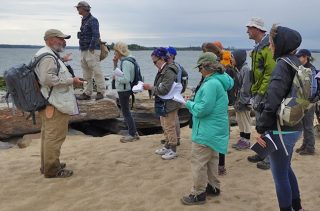NYBG’s Urban Naturalist Program: Become a Steward of Your Urban Environment
Posted in Learning Experiences on September 5, 2017 by Stevenson Swanson
Stevenson Swanson is the Science Media Manager at The New York Botanical Garden.
 Even in this teeming metropolis, nature is all around us. You just have to look for it. But it helps to know what you’re looking for and what you’re seeing when you’ve found it.
Even in this teeming metropolis, nature is all around us. You just have to look for it. But it helps to know what you’re looking for and what you’re seeing when you’ve found it.
That’s where The New York Botanical Garden’s Urban Naturalist Program comes in.
Called “life-changing” by students who took the course this spring, the fall Urban Naturalist Program will equip you with the observation, interpretation and documentation skills necessary to become a citizen scientist and an effective environmental steward. Led by Mike Feller, our team of expert naturalists, including Ken Chaya and Nancy Slowik, will use the Botanical Garden’s grounds and select New York City parks as living labs to investigate the interrelationships between species and discover how our urban environment sustains those ecosystems.
Spring 2017 NYBG Urban Naturalists are already using their newfound knowledge and skills to document New York City plant species as volunteers in the NYBG EcoFlora project, manage invasive species in local parks, and develop their own projects.
This fall, NYBG is offering a choice of two tracks to become an Urban Naturalist.
You can jump into the full, six-week Fall Intensive, starting September 13 and running until November 4, with class sessions on Wednesdays, Thursdays, and Saturdays from 10 a.m. to 2 p.m. You’ll tag monarch butterflies, identify fall wildflowers, and document the bird migration along the Atlantic Flyway. Covering the three classes required to become a NYBG Urban Naturalist—Foundations, Woodlands, and Waterways—you’ll get field experience in Pelham Bay Park, Marine Park, Van Cortlandt Park, and Inwood Hill Park under the guidance of our expert naturalists
Or, you can start with one of the core requirements, Foundations, starting November 29, with two weeks of classes on Wednesdays, Thursdays, and Saturdays from 10 a.m. to 2 p.m. You’ll hone your ability to identify plants and animals, using a hand lens, identification keys, and field guides. Significant time will be spent on Garden grounds. This course is the foundation to the Urban Naturalist Program.
You can learn more or register here.

